Figures & data
Figure 1. Plant growth promoting traits of sweet potato endophytic isolates. (a) In vitro test for IAA-producing potential of endophytes. (b) Quantitative estimation of ammonia production by bacterial isolates. (c) Growth potential of endophytes in NA medium with different NaCl concentrations. (d) Growth potential of endophytes in NA medium with different PEG-6000 concentrations. Values are the means (n = 4) with corresponding standard deviations. Different letters indicate significant differences analyzed by ANOVA (P < 0.05).

Figure 2. Amplification and analysis of 16S rRNA of Klebsiella sp. San01. (a) Amplification of 16s rRNA sequence of San01 by genomic PCR. (b) Phylogenetic analysis of Klebsiella sp. San01 to closely related bacteria. The 16S rRNA gene sequences of closely related species were retrieved from NCBI GenBank database.
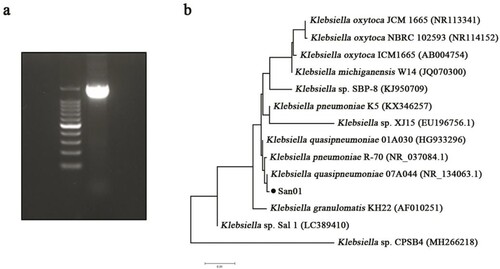
Figure 3. Effect of Klebsiella sp. San01 on the growth of the sweet potato. Phenotypic comparisons of shoot (a) and root (b) between San01-inoculated (+San01) and non-inoculated (−San01) sweet potato plants were observed after four weeks of inoculation. (c) Effect of San01 on the fresh weights of shoot and root in sweet potato plants after inoculation. Values are the means (n = 8) with corresponding standard deviations. Statistical significance between San01-inoculated and non-inoculated plants was examined by Student’s t-test (*P < 0.05; **P < 0.01).

Figure 4. Impact of Klebsiella sp. San01 on the growth of sweet potato under salt and drought treatments. The representative photographs of the San01-inoculated (+San01) and non-inoculated (−San01) sweet potato plants were taken after 14 days of salt treatment (a) and drought treatment (b). Changes in biomass of +San01 and −San01 plants exposed to salt treatment (c) and drought treatment (d). Values are the means (n = 8) with corresponding standard deviations. Statistical significance between San01-inoculated and non-inoculated plants was examined by Student’s t-test (*P < 0.05; **P < 0.01).
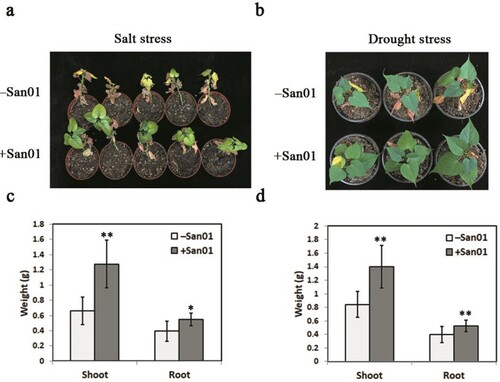
Figure 5. Effects of Klebsiella sp. San01 on physiological parameters, including Fv/Fm (a), RWC (b), chlorophyll (Chla and Chl b) contents (c), and carotenoid contents (d) in leaves of sweet potato plants exposed to non-stress, salt, and drought conditions. Values are the means (n ≥ 4) with corresponding standard deviations. Statistical significance between San01-inoculated plants (+) and non-inoculated plants (−) was examined by Student’s t-test (*P < 0.05; **P < 0.01)
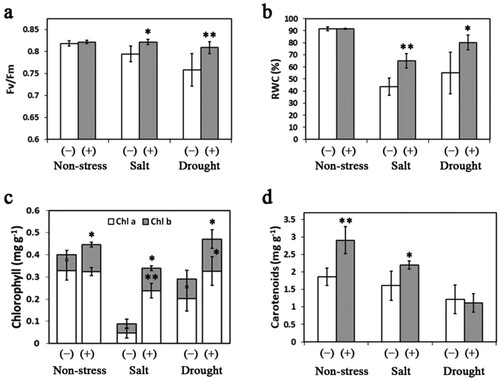
Figure 6. The impacts of Klebsiella sp. San01 on antioxidant activity and ROS accumulation of sweet potato plants exposed to salinity and drought. The DPPH-radical scavenging ability (a) and H2O2 accumulation (b) were determined in San01-inoculated (+) and non-inoculated (−) sweet potato plants under non-stress, salt, and drought conditions. Values are the means (n = 5) with corresponding standard deviations. Statistical significance between San01-inoculated plants and non-inoculated plants was examined by Student’s t-test (*P < 0.05; **P < 0.01).
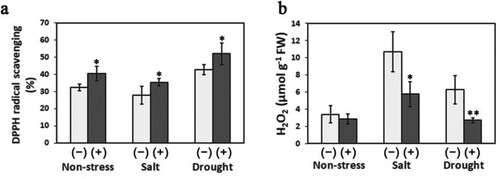
Table 1. The activities of APX, CAT, and SOD in the leaves of San01-inoculated and non-inoculated sweet potato plants under non-stress, salt, and drought treatments.
Figure 7. Expression analysis of salt- and drought-related genes in San01-inoculated (+) and non-inoculated (−) plants under non-stress, salt, and drought treatments. Fold changes of gene expression levels were calibrated by the non-inoculated plants in each treatment. Values are the means (n = 5) with corresponding standard deviations. Statistical significance between San01-inoculated plants and non-inoculated plants was examined by Student’s t-test (*P < 0.05; **P < 0.01).
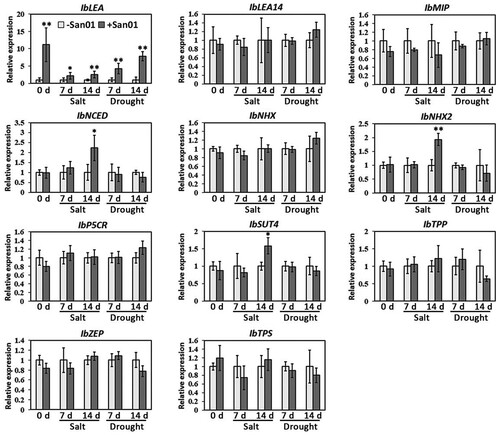
Table 2. Plant colonization of Klebsiella sp. San01.
Supplemental Material
Download TIFF Image (8.8 MB)Supplemental Material
Download PDF (89.5 KB)Data availability statement
The datasets generated during and/or analyzed during the current study are available from the corresponding author on reasonable request.
